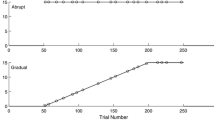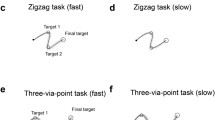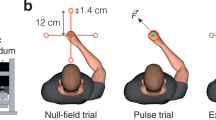Abstract.
Some characteristics of arm movements that humans exhibit during learning the dynamics of reaching are consistent with a theoretical framework where training results in motor commands that are gradually modified to predict and compensate for novel forces that may act on the hand. As a first approximation, the motor control system behaves as an adapting controller that learns an internal model of the dynamics of the task. It approximates inverse dynamics and predicts motor commands that are appropriate for a desired limb trajectory. However, we had previously noted that subtle motion characteristics observed during changes in task dynamics challenged this simple model and raised the possibility that adaptation also involved sensory–motor feedback pathways. These pathways reacted to sensory feedback during the course of the movement. Here we hypothesize that adaptation to dynamics might also involve a modification of how the CNS responds to sensory feedback. We tested this through experiments that quantified how the motor system's response to errors during voluntary movements changed as it adapted to dynamics of a force field. We describe a nonlinear approach that approximates the impedance of the arm, i.e., force response as a function of arm displacement trajectory. We observe that after adaptation, the impedance function changes in a way that closely matches and counters the effect of the force field. This is particularly prominent in the long-latency (>100 ms) component of response to perturbations. Therefore, it appears that practice not only modifies the internal model with which the brain generates motor commands that initiate a movement, but also the internal model with which sensory feedback is integrated with the ongoing descending commands in order to respond to error during the movement.
Similar content being viewed by others
Author information
Authors and Affiliations
Additional information
Received: 10 January 2001 / Accepted in revised form: 30 May 2001
Rights and permissions
About this article
Cite this article
Wang, T., Dordevic, G. & Shadmehr, R. Learning the dynamics of reaching movements results in the modification of arm impedance and long-latency perturbation responses. Biol Cybern 85, 437–448 (2001). https://doi.org/10.1007/s004220100277
Issue Date:
DOI: https://doi.org/10.1007/s004220100277




